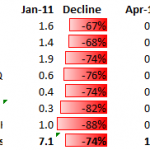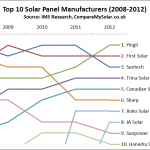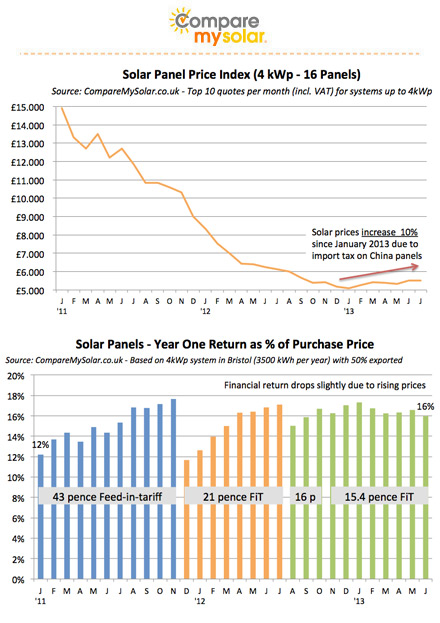 At the end of 2012 there were 100 gigawatt of solar panels installed! This milestone of cumulative solar capacity was reported by EPIA, the European Photovoltaic Industry Association, earlier this year. Growth was especially strong in 2011 and 2012, with both years adding about 30 gigawatt of capacity. But how many solar panels are we really talking about? Continue reading
At the end of 2012 there were 100 gigawatt of solar panels installed! This milestone of cumulative solar capacity was reported by EPIA, the European Photovoltaic Industry Association, earlier this year. Growth was especially strong in 2011 and 2012, with both years adding about 30 gigawatt of capacity. But how many solar panels are we really talking about? Continue reading
Category Archives: Links
Best Solar Panels: Top Chinese Manufacturers Drop Further 50% in Value in Last Year
 We previously discussed the top 10 Global Solar Panel manufacturers as a safe choice when selecting your best solar panel. The rationale was that reputable companies will survive for the next 5-10 years hence you as a consumer can actually claim your warranty if needed. However, the share price of the top Chinese manufacturers has continued to drop by a huge 50% in the last year, after a previous 75% drop in since the start of 2011. Continue reading
We previously discussed the top 10 Global Solar Panel manufacturers as a safe choice when selecting your best solar panel. The rationale was that reputable companies will survive for the next 5-10 years hence you as a consumer can actually claim your warranty if needed. However, the share price of the top Chinese manufacturers has continued to drop by a huge 50% in the last year, after a previous 75% drop in since the start of 2011. Continue reading
Best Solar Panels – Top 10 Global Manufacturers (2008-2012)
 Every year IMS Research publishes a list of the 10 largest global solar panel manufacturers. When picking solar panels it is important to choose a large manufacturer, since your panel warranty often is valid for 25 years. Top 10 companies are more likely to be around in 25 years time than small ones, so this list (updated for 2012) is important in picking your best solar panel: Continue reading
Every year IMS Research publishes a list of the 10 largest global solar panel manufacturers. When picking solar panels it is important to choose a large manufacturer, since your panel warranty often is valid for 25 years. Top 10 companies are more likely to be around in 25 years time than small ones, so this list (updated for 2012) is important in picking your best solar panel: Continue reading
Battery Backup will increase the return of solar panels
 The next big thing in solar panels is all about battery backup. This means integrating batteries with your solar panels to store the electricity that is generated during the day and use this electricity at night. This article gives an overview of what battery backup means and how it will impact the return of solar panels in the UK.
The next big thing in solar panels is all about battery backup. This means integrating batteries with your solar panels to store the electricity that is generated during the day and use this electricity at night. This article gives an overview of what battery backup means and how it will impact the return of solar panels in the UK.
10 Year Forecast of Solar Panel Prices
 In the last two years solar panel prices have dropped dramatically – from nearly 15.000 pounds for a 4kWp system towards 5.0000 pounds. But how are prices expected to develop in the future? The clean-tech advisory firm Clean Edge has developed a 10 year price forecast in US dollars, and based on this we can forecast prices in the UK as well. Continue reading
In the last two years solar panel prices have dropped dramatically – from nearly 15.000 pounds for a 4kWp system towards 5.0000 pounds. But how are prices expected to develop in the future? The clean-tech advisory firm Clean Edge has developed a 10 year price forecast in US dollars, and based on this we can forecast prices in the UK as well. Continue reading
Feed-in-Tariff of 15.44 pence stable till July 2013
As just announced by Ofgem, the solar Feed-in-Tariff of 15.44 pence will remain available until July this year. That means there are two more months (May and June) to make use of this attractive Feed-in-Tariff rate for solar panels, especially since financial returns are currently at their highest level since the introduction of the FiT in 2010. Continue reading
February 2013 Solar Panel Prices: 4kWp from £5.100
Solar panel prices continued their price drop into 2013 and have dropped by two-thirds in price since early 2011. A 4kWp system (16 solar panels) that used to cost £15.000 is currently available from £5.100. On a South-facing roof in these panels will pay back about £1.000 per year, which is a return of 20%. Due to these price drops, solar panels still provide an great return despite the Feed-in-Tariff subsidy cuts. 
Solar Panel Price Index: from £15.000 towards £5.100
Our price index for solar panels (incl. VAT and installation) is currently 65% lower than early 2011. More and more installers are currently offering prices below £6.000 The lowest prices are around £5.000, and we expect the rest of the market to follow this direction. Our expectation is that prices will stabilize around £5.000-£5.500 due to consumer demand picking up this Spring. Some actual examples of low prices are:
Newcastle solar panels: £5.600 for 4kWp (Advanced Renewable Power)
Manchester solar panels: £5.100 for 4kWp (CTS Renewables)
Kent solar panels: £5.400 for 4kWp (RK Solar)
Bristol solar panels: £5.000 for 3.8kWp (Your Power UK)
Return excellent on 15.4 pence Feed-in-Tariff
On a South-facing roof in e.g. Exeter a 4kWp system will produce around 4.000 kWh per year. This will provide a year one return of around £1.000 (based on 15.44 pence FiT and 50% of electricity exported), which is around 20% on the best available solar panel prices (around £5.100), as shown in the second graph. The current financial return is better than nearly every month during the high (21p or 43p) Feed-in-Tariff rates due to the strong price drops of solar panels. We expect the solar panel return to stabilize in the next few months due to fewer prices cuts from solar installers.
Telegraph loses some credibility with ‘bills to rise’ scare for promotion of switching service.
 The Telegraph, one of the quality newspapers in the UK, has lost some of it’s credibility by their reporting on the latest Energy Bill. The headline “Wind farms to increase energy bills by £178 a year” is in our opinion a bit misleading.. Continue reading
The Telegraph, one of the quality newspapers in the UK, has lost some of it’s credibility by their reporting on the latest Energy Bill. The headline “Wind farms to increase energy bills by £178 a year” is in our opinion a bit misleading.. Continue reading
Supermarket Solar: Tesco not the cheapest
 Tesco has been pushing their ‘solar price drop’ and are advertising heavily online to sell their solar panel systems. They promise a ‘7 year payback time’ and a ‘14.57% ROI’ – but are the Tesco solar panel systems actually priced attractively? The answer is no, you can overpay as much as 1.000 pounds by going for supermarket solar..
Tesco has been pushing their ‘solar price drop’ and are advertising heavily online to sell their solar panel systems. They promise a ‘7 year payback time’ and a ‘14.57% ROI’ – but are the Tesco solar panel systems actually priced attractively? The answer is no, you can overpay as much as 1.000 pounds by going for supermarket solar..
IEA: World Energy Outlook 2012 – Renewables growing fast, Solar fastest.
 The 2012 release of the World Energy Outlook from the reputable International Energy Agency (IEA) takes a long term global perspective on energy supply and demand. It predicts that renewables will become the world’s second-largest source of power generation by 2015. Solar grows more rapidly than any other renewable technology. And by 2035, renewables are forecast to account for almost one-third of total electricity output. Continue reading
The 2012 release of the World Energy Outlook from the reputable International Energy Agency (IEA) takes a long term global perspective on energy supply and demand. It predicts that renewables will become the world’s second-largest source of power generation by 2015. Solar grows more rapidly than any other renewable technology. And by 2035, renewables are forecast to account for almost one-third of total electricity output. Continue reading
